Coagulation Analyzers Market Size and Share
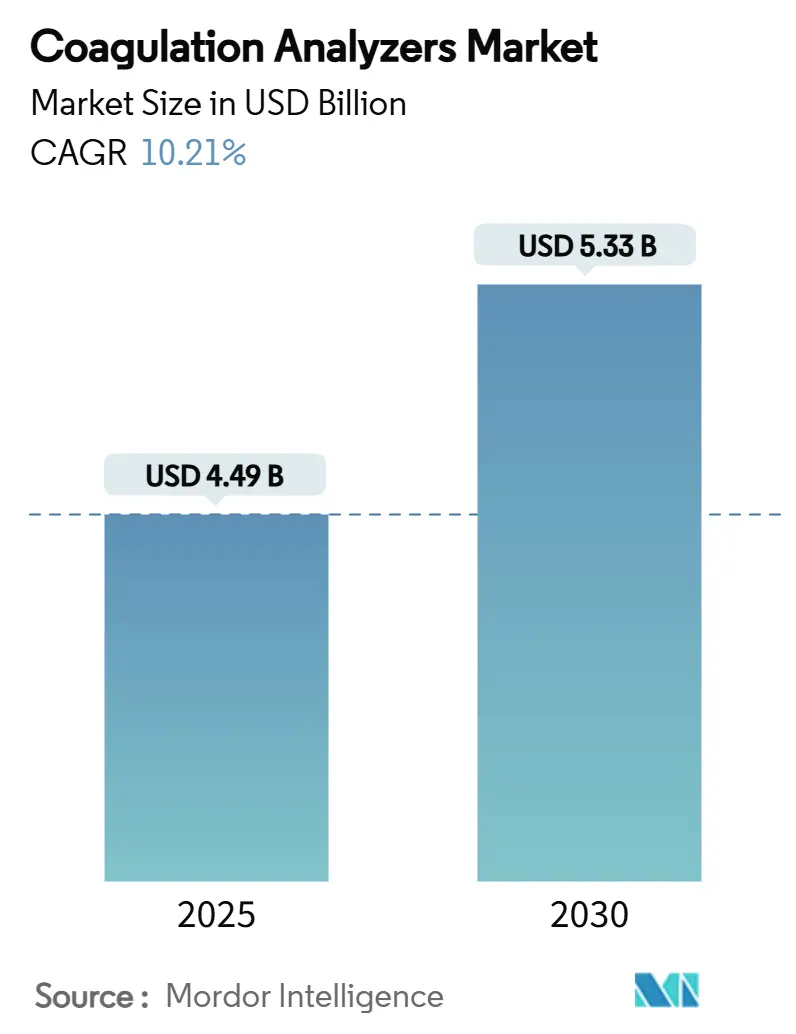
Coagulation Analyzers Market Analysis by Mordor Intelligence
The coagulation analyzers market size stands at USD 4.49 billion in 2025 and is forecast to touch USD 5.33 billion by 2030, advancing at a 6.2% CAGR. Growth stems from the shift toward real-time viscoelastic platforms, tighter quality regulations, and wider adoption of AI-guided dosing that trims adverse events by 30% compared with conventional monitoring. Viscoelastic analyzers deliver complete clotting profiles within minutes, enabling surgical teams to save blood products and shorten operating room time. At the same time, Class II re-classification in May 2025 has lowered regulatory barriers, encouraging regional manufacturers to enter the coagulation analyzers market and diversify supply. Intensifying M&A activity—such as Werfen’s purchase of Accriva and the long-term Siemens–Sysmex OEM pact—signals a race to secure reagent lines and embedded analytics.
Key Report Takeaways
- By product, systems and analyzers led with 60.2% revenue share in 2024; point-of-care analyzers are projected to ramp up at an 11.7% CAGR to 2030.
- By test type, PT/INR accounted for 30.6% of the coagulation analyzers market size in 2024, while D-Dimer assays are on course for a 12.4% CAGR through 2030.
- By technology, optical methods held 43.1% of the coagulation analyzers market share in 2024; viscoelastic/magnetic technologies are forecast to rise at 14.4% CAGR between 2025 and 2030.
- By modality, hospital-based central laboratories captured 54.4% share of the coagulation analyzers market size in 2024; point-of-care devices are poised for a 15.9% CAGR through 2030.
- By geography, North America led with a 43.5% share of the coagulation analyzers market in 2024, while Asia-Pacific is set to register the fastest growth at an 16.1% CAGR between 2025 and 2030.
Global Coagulation Analyzers Market Trends and Insights
Drivers Impact Analysis
| Driver | ( ~ ) % Impact on CAGR Forecast | Geographic Relevance | Impact Timeline |
|---|---|---|---|
| Growing prevalence of bleeding & thrombotic disorders | +1.80% | Global, higher in aging populations | Long term (≥ 4 years) |
| Aging population & chronic-disease burden | +1.50% | Developed markets | Long term (≥ 4 years) |
| Laboratory automation & high-throughput analyzers | +1.20% | North America & Europe | Medium term (2–4 years) |
| Rise of point-of-care clotting tests | +1.00% | Emergency and surgical settings worldwide | Medium term (2–4 years) |
| Rapid uptake of viscoelastic testing | +0.80% | North America & Europe | Short term (≤ 2 years) |
| AI-driven, patient-specific algorithms | +0.60% | Early adoption in North America & Europe | Long term (≥ 4 years) |
| Source: Mordor Intelligence | |||
Growing Prevalence of Bleeding & Thrombotic Disorders
Hemophilia affects 273,000 diagnosed individuals, with an additional 563,000 likely undiagnosed, elevating demand for precise coagulation monitoring.[1]James O’Donnell, “Global Hemophilia Burden,” frontiersin.orgVon Willebrand disease remains the most common hereditary bleeding disorder, and 72–94% of patients experience clinical bleeding episodes that benefit from rapid laboratory confirmation. New therapies such as fitusiran, cleared by the FDA in March 2025, require antithrombin assays, further broadening the coagulation analyzers market.
Ageing Population & Chronic-Disease Burden
Surging atrial fibrillation prevalence in seniors heightens long-term anticoagulation needs. Thromboelastography demonstrates superior bleed-prediction accuracy versus conventional tests in elderly cohorts. Direct oral anticoagulant uptake, led by apixaban, underlines a market pivot toward newer drugs that still warrant episodic coagulation checks.[2]Wei Zhang, “Carbon-Nanotube Fluorescent Clot Sensor,” mdpi.com
Laboratory Automation & High-Throughput Analyzers
Platforms such as Sysmex CS-5100 process up to 402 tests per hour with ≤3% CV, meeting hospitals’ drive for turnaround time under 60 minutes. Siemens’ Atellica COAG 360 posts 98% operator satisfaction, highlighting usability gains vital for the coagulation analyzers market.
Rise of Point-of-Care Clotting Tests
Handheld INR meters deliver lab-equivalent accuracy, fostering home-based therapy adjustment and unclogging outpatient clinics.[3]Kenneth Uhl, “Handheld INR Accuracy,” mayoclinicproceedings.org The April 2024 TEG 6s HN cartridge brings viscoelastic insight to heparinized cardiac cases, trimming transfusion rates
Restraints Impact Analysis
| Restraint | ( ~ ) % Impact on CAGR Forecast | Geographic Relevance | Impact Timeline |
|---|---|---|---|
| High capital & reagent costs | -1.20% | Emerging markets worldwide | Medium term (2–4 years) |
| Limited adoption in low-income nations | -0.80% | Sub-Saharan Africa & parts of Asia | Long term (≥ 4 years) |
| Reagent-supply shocks from porcine heparin & IVDR | -0.60% | Global supply chains | Short term (≤ 2 years) |
| Emerging non-invasive biomarkers | -0.40% | North America & Europe | Long term (≥ 4 years) |
| Source: Mordor Intelligence | |||
Segment Analysis
By Product: Automation Drives Systems Dominance
Systems and analyzers held a 60.2% share of the coagulation analyzers market in 2024 as laboratories prioritized walk-away automation to control rising test volumes without adding staff. Point-of-care units posted the quickest uptake, supported by the TEG 6s clearance that expanded viscoelastic testing into cardiac theaters. Robust throughput—402 tests per hour on high-end models—reduces bottlenecks during morning phlebotomy peaks, cementing vendor lock-in through consumable contracts.
Consumables form the recurring backbone of the coagulation analyzers market. Reagent integrity demands have sharpened since porcine-heparin contamination alerts triggered global recalls. In response, OEM alliances such as the 2024 Siemens–Sysmex pact guarantee steady reagent pipelines and forward-integration of AI-enabled QC packs. Calibration materials also benefit from stricter CLIA precision goals, nudging laboratories toward premium controls with validated lot-to-lot consistency.
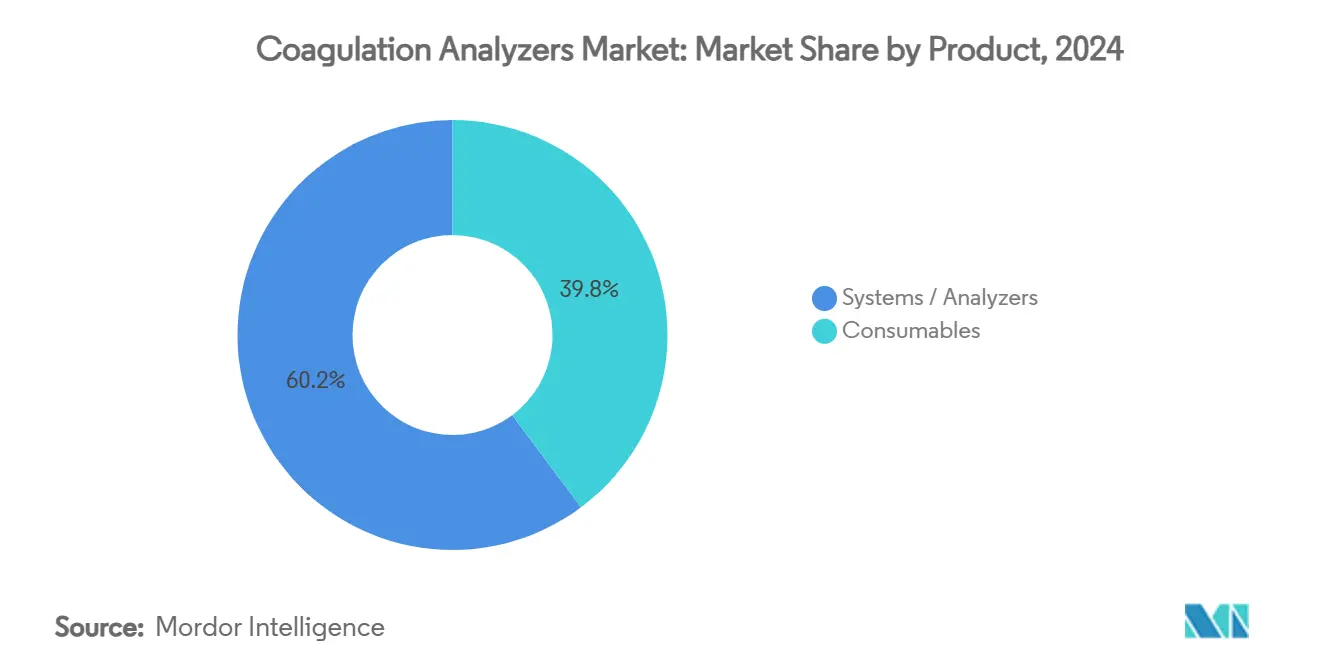
Note: Segment shares of all individual segments available upon report purchase
By Test Type: D-Dimer Surges Amid Thrombosis Focus
PT/INR continues to anchor chronic warfarin surveillance, capturing 30.6% of coagulation analyzers market size in 2024. Nonetheless, clinicians increasingly prefer anti-Xa assays for low-molecular-weight heparin, reflecting therapy migration. D-Dimer, meanwhile, is posting the fastest 12.4% CAGR as emergency departments rely on it to triage venous thromboembolism and monitor post-COVID coagulopathy.
Fibrinogen and platelet-function panels round out the catalog, supporting trauma protocols and antiplatelet agent adjustment. Global hemostasis applications—TEG and ROTEM—are expanding beyond operating theaters into intensive-care settings, fueled by the May 2025 Class II reclassification that trimmed time-to-market for new cartridges.
By Technology: Viscoelastic Methods Challenge Optical Dominance
Optical analyzers retained a 43.1% coagulation analyzers market share in 2024 thanks to deep installed bases and mature QC frameworks. Even so, viscoelastic and magnetic modalities are scheduled for a 14.4% CAGR as perioperative teams seek whole-blood insight that standard photometric curves cannot provide. Portable viscoelastic units now fit on anesthesia carts, tightening feedback loops during liver resections.
Electrochemical chips and smartphone-linked optical sensors are moving from proof-of-concept to pilot deployments in outpatient anticoagulation clinics. Researchers report successful clot-time tracking via carbon-nanotube fluorescence, hinting at low-cost disposables that could open the coagulation analyzers market to community pharmacies.
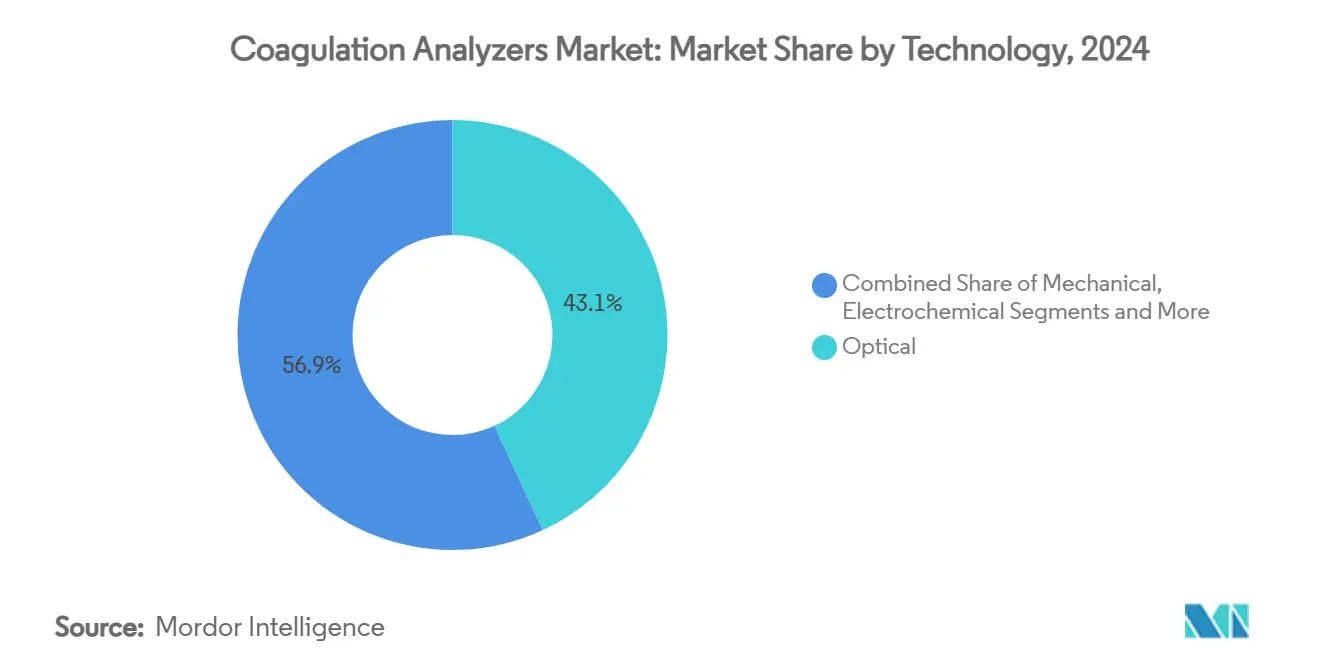
Note: Segment shares of all individual segments available upon report purchase
By Modality: Point-of-Care Gains Ground
Central laboratories still dominate hospital contracts because they deliver broad menus and bulk reagent discounts. Yet point-of-care models logged a 15.9% CAGR as caregivers push testing to bedsides for trauma, transplant, and obstetric cases, where 10-minute answers alter surgical decisions.
Home-care self-testing represents the next frontier. Pocket INR meters paired with cloud dashboards show stable time-in-therapeutic range and fewer clinic visits, aligning with payer incentives for remote management. However, reimbursement clarity and operator-training thresholds vary, limiting near-term rollouts outside high-income countries.
By End User: Home-Care Emerges as Growth Leader
Hospitals accounted for 54.4% of revenue in 2024, reflecting comprehensive in-house need across emergency, surgery, and specialized coagulation clinics. Clinical reference labs handle esoteric factor analyses and genetic panels that smaller hospitals outsource.
Home-care lines, projected to grow 15.9% annually, benefit from population aging and digital literacy improvements. Wearable biosensors under development promise continuous coagulation trendlines rather than spot checks, potentially shrinking readmission risk in heart-failure patients receiving dual antithrombotic therapy.
Geography Analysis
North America leads the coagulation analyzers market, supported by well-funded hospitals, rapid AI adoption, and favorable reimbursement frameworks. The March 2025 FDA approval of fitusiran with a companion antithrombin assay illustrates how therapeutic innovation immediately triggers diagnostic demand. Canada’s single-payer model drives nationwide INR management networks, while Mexico’s emerging private hospital chains are investing in point-of-care devices to shorten emergency room stay times.
Asia Pacific is the fastest-advancing region, reflecting swift infrastructure upgrades and growing senior populations that require routine coagulation surveillance. China’s role as the world’s largest heparin supplier offers cost advantages but also vulnerability to raw-material shocks. Japan’s stringent device review process ensures high laboratory standards, whereas recent regulatory reforms in India have opened pathways for domestic manufacturing of mid-throughput analyzers. Sysmex reported double-digit regional sales growth in Q1 2025, underscoring unmet demand for reagents and controls.
Europe balances strong scientific capability with the added burden of IVDR compliance. Germany, France, and the United Kingdom operate expansive reference-lab networks that already meet most new documentation mandates, but smaller centers face costly validation work. Supply concerns around porcine-derived reagents have sparked pilot studies into bovine alternatives, while NHS blood shortage episodes in England spotlight the importance of viscoelastic testing for judicious transfusion practice.
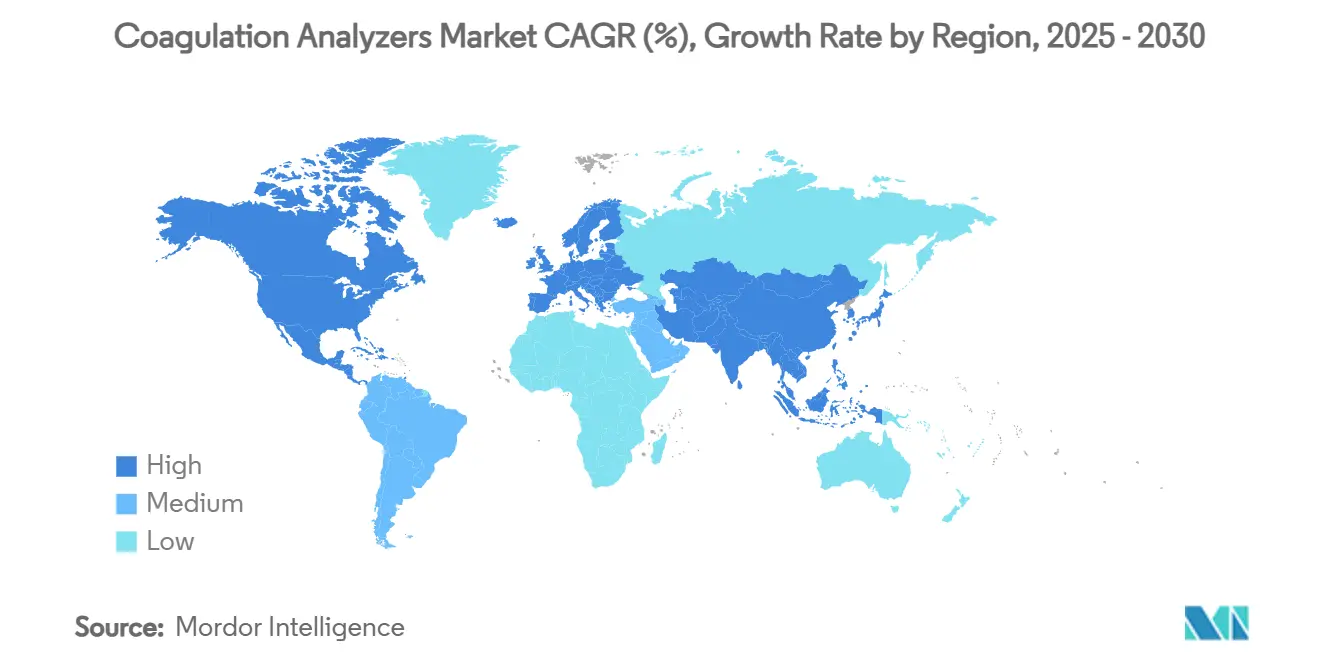
Competitive Landscape
The coagulation analyzers market exhibits moderate consolidation: the top five vendors control an estimated two-thirds of global revenue, yet technological churn allows nimble entrants to secure niche footholds. Siemens Healthineers and Sysmex extend a 25-year alliance through a fresh OEM deal that bundles instruments and reagents under shared service contracts. Roche strengthens its high-throughput position with Factor Xa tests tailored to direct oral anticoagulant monitoring.
Werfen deepened its point-of-care reach by acquiring Accriva Diagnostics, gaining Hemochron and VerifyNow to complement its laboratory GEM line. Haemonetics focuses on viscoelastic leadership, adding heparin-neutralized cartridges to cover cardiovascular surgeries. Across the tier-two scene, start-ups leverage AI to convert raw clot curves into predictive bleed-risk scores, pitching cloud APIs that fit alongside legacy LIS systems.
Competitive pressure is likely to intensify as pharmaceutical firms seek companion diagnostics synchronized with next-generation anticoagulants. The May 2025 easing of U.S. regulatory classification for viscoelastic systems also lowers capital hurdles for local manufacturers, potentially fragmenting share in price-sensitive segments.
Coagulation Analyzers Industry Leaders
-
F. Hoffmann-La Roche Ltd
-
Siemens Healthineers AG
-
Sysmex Corporation
-
Beckman Coulter (Danaher)
-
Werfen (Instrumentation Laboratory)
- *Disclaimer: Major Players sorted in no particular order
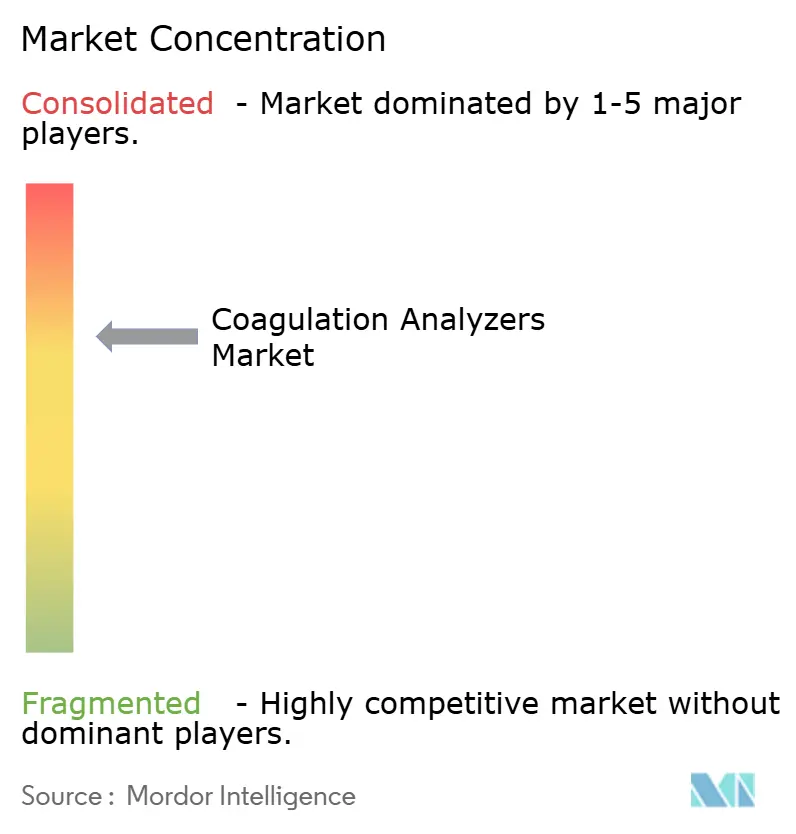
Recent Industry Developments
- May 2025: The FDA approved Qfitlia (fitusiran), which requires INNOVANCE Antithrombin monitoring and has been shown to cut annual bleeding episodes by 71–73% in pivotal trials.
- April 2024: Haemonetics gained 510(k) clearance for the TEG 6s Global Hemostasis-HN cartridge aimed at heparinized cardiac cases,
- February 2024: Siemens Healthineers and Sysmex renewed a global OEM agreement covering hemostasis instruments and reagents.
- February 2024: Werfen completed the acquisition of Accriva Diagnostics, reinforcing its hospital point-of-care coagulation lineup.
Research Methodology Framework and Report Scope
Market Definitions and Key Coverage
According to Mordor Intelligence, we define the coagulation analyzers market as all automated or semi-automated laboratory and point-of-care instruments that quantify plasma clotting parameters, such as PT/INR, aPTT, D-dimer, and viscoelastic endpoints, together with the associated reagent kits and quality-control consumables, valued at manufacturer selling price across hospitals, independent labs, trauma centers, and home-care programs.
Scope exclusion: Analyzers limited to complete-blood-count only, reagent-rental contracts without instrument revenue, and veterinary devices fall outside this study.
Segmentation Overview
- By Product
- Systems / Analyzers
- High-throughput Lab Analyzers
- Mid-throughput Lab Analyzers
- Point-of-Care Analyzers
- Consumables
- Reagents & Assays
- Calibrators & Controls
- Others
- Systems / Analyzers
- By Test Type
- Prothrombin Time (PT/INR)
- Activated Partial Thromboplastin Time (aPTT)
- D-Dimer
- Fibrinogen
- Platelet Function
- Anti-Factor Xa
- Global Hemostasis (TEG/ROTEM)
- Other Tests
- By Technology
- Optical
- Mechanical
- Electrochemical
- Magnetic / Viscoelastic
- Other Technologies
- By Modality
- Central-Laboratory Platforms
- Point-of-Care Devices
- Self-Testing / Home-care Devices
- By End User
- Hospitals
- Clinical & Reference Laboratories
- Ambulatory Surgical Centers
- Home-care Settings
- Others
- Geography
- North America
- United States
- Canada
- Mexico
- Europe
- Germany
- United Kingdom
- France
- Italy
- Spain
- Rest of Europe
- Asia Pacific
- China
- Japan
- India
- South Korea
- Australia
- Rest of Asia Pacific
- Middle East & Africa
- GCC
- South Africa
- Rest of Middle East & Africa
- South America
- Brazil
- Argentina
- Rest of South America
- North America
Detailed Research Methodology and Data Validation
Primary Research
Our team interviewed clinical pathologists in North America, biomedical engineers at high-volume EU hospitals, purchasing leads across six ASEAN provider chains, and product managers at reagent manufacturers. These conversations clarified average test throughput, service-contract mark-ups, and the rate at which viscoelastic platforms are replacing optical benches, allowing us to refine assumptions highlighted during desk work.
Desk Research
We began with authoritative public datasets that track bleeding-disorder prevalence and treatment volumes, including the World Federation of Hemophilia survey, WHO Global Health Observatory, Eurostat hospital activity tables, and the US CDC National Hospital Ambulatory Survey. Trade codes for thromboplastin reagents from UN Comtrade and India's DGCIS helped us gauge cross-border reagent flows, while FDA 510(k) and EUDAMED listings mapped the installed equipment base. Company 10-Ks, investor roadshows, tender portals, plus premium libraries such as D&B Hoovers and Dow Jones Factiva supplied pricing and placement clues. This list is illustrative; many other sources informed data gathering and validation.
Market-Sizing & Forecasting
A top-down build tracks inpatient discharges for anticoagulant therapy, multiplies them by validated panel frequencies, and then layers outpatient self-testing penetration to reach total test volumes. We corroborate totals with a selective bottom-up roll-up of supplier shipments and average selling prices. Core variables include installed analyzer base, aging population growth, direct oral anticoagulant patient pool, reagent ASP progression, share of point-of-care units, and typical PT/INR test frequency. Multivariate regression projects each driver to 2030, while scenario analysis is used where guideline or reimbursement shifts could materially alter uptake. Gap areas in the bottom-up roll-up are bridged by regional midpoint estimates that draw on neighboring markets with comparable procurement structures.
Data Validation & Update Cycle
Outputs undergo dual-analyst variance checks; any swing beyond three percentage points versus the prior edition triggers a re-contact of at least one primary source in each region before senior sign-off. Mordor refreshes the full model every twelve months and issues interim revisions whenever major product recalls, regulatory approvals, or reimbursement changes occur, so clients always receive the latest view.
Why Mordor's Coagulation Analyzers Baseline commands reliability
Published estimates often diverge because firms choose different product mixes, exchange-rate bases, and refresh cadences. Our disciplined scope, yearly updates, and balanced use of primary evidence narrow these gaps.
Key gap drivers include whether point-of-care devices are counted, the way reagent ASP erosion is modeled, and the depth of primary validation; some publishers also apply aggressive adoption curves or outdated currency conversions that our interviews did not confirm.
Benchmark comparison
| Market Size | Anonymized source | Primary gap driver |
|---|---|---|
| 4.49 B, 2025 | Mordor Intelligence | - |
| 3.77 B, 2025 | Global Consultancy A | Excludes PoC analyzers and uses list prices without primary checks |
| 4.80 B, 2024 | Industry Research Firm B | Bundles clotting-factor assay consumables and fixes FX at prior-year rates |
These comparisons show that Mordor's numbers rest on transparent variables, balanced assumptions, and repeatable steps, giving decision-makers a dependable starting point.
Key Questions Answered in the Report
What is the current size and growth outlook for the global coagulation analyzers market?
The market is valued at USD 4.49 billion in 2025 and is projected to reach USD 5.33 billion by 2030, reflecting a 6.2% CAGR.
Which product category is expanding the quickest?
Point-of-care analyzers are growing at an 11.7% CAGR as hospitals and emergency units prioritize bedside coagulation results.
Why is viscoelastic testing (TEG/ROTEM) gaining rapid adoption?
These platforms deliver real-time, whole-blood clotting profiles within minutes, improving transfusion decisions and benefiting from a May 2025 Class II re-classification that lowered regulatory hurdles.
Which geographic region is forecast to grow the fastest?
Asia Pacific leads with a 16.1% CAGR due to aging populations, infrastructure upgrades, and rising chronic-disease burdens.
Page last updated on:



